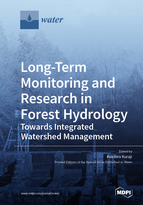Long-Term Monitoring and Research in Forest Hydrology: Towards Integrated Watershed Management
A special issue of Water (ISSN 2073-4441). This special issue belongs to the section "Hydrology".
Deadline for manuscript submissions: closed (25 March 2022) | Viewed by 29813
Special Issue Editor
Interests: forest hydrology; water balance; evapotranspiration; rainfall interception; surface runoff; integrated land and water management; flood disaster; water resources; payment of environmental services
Special Issues, Collections and Topics in MDPI journals
Special Issue Information
Dear Colleagues,
Forest hydrology, as a discipline, was designed to address the fundamental questions regarding the impacts of deforestation on flood and drought. Recently, forest hydrology has become a primary discipline in biophysical sciences to clarify how forests and water interact with each other. Despite the remarkable and detailed progress of research into forest hydrology, the original questions have not yet been fully answered. Additionally, the knowledge gained through this research has not yet been integrated into forest and water management in the real world. Recently, payment for environmental services (PES) schemes was made available as a new tool for forest and water management, but most of these schemes fail to consider the recent advances in forest hydrology.
The influence of global warming continues to grow, and extreme weather events are increasing in frequency, posing threats to people and property. To sustain and manage forests and water resources and avoid and mitigate disasters, it is an important and urgent challenge to understand long-term hydrological changes in forests and to provide robust scientific knowledge on the response of forest and water resources to those changes. Such detection of environmental changes and ecosystem responses requires baseline datasets based on long-term hydrological observations of forests. In recent years, the number of long-term forest hydrology observation sites has increased.
The aim of this Special Issue is to gather both recent scientific research of forest hydrology based on long-term data and integrated watershed management based on current research in forest hydrology. All types of manuscripts (original research, reviews, etc.) are welcome.
Prof. Dr. Koichiro Kuraji
Guest Editor
Manuscript Submission Information
Manuscripts should be submitted online at www.mdpi.com by registering and logging in to this website. Once you are registered, click here to go to the submission form. Manuscripts can be submitted until the deadline. All submissions that pass pre-check are peer-reviewed. Accepted papers will be published continuously in the journal (as soon as accepted) and will be listed together on the special issue website. Research articles, review articles as well as short communications are invited. For planned papers, a title and short abstract (about 100 words) can be sent to the Editorial Office for announcement on this website.
Submitted manuscripts should not have been published previously, nor be under consideration for publication elsewhere (except conference proceedings papers). All manuscripts are thoroughly refereed through a single-blind peer-review process. A guide for authors and other relevant information for submission of manuscripts is available on the Instructions for Authors page. Water is an international peer-reviewed open access semimonthly journal published by MDPI.
Please visit the Instructions for Authors page before submitting a manuscript. The Article Processing Charge (APC) for publication in this open access journal is 2600 CHF (Swiss Francs). Submitted papers should be well formatted and use good English. Authors may use MDPI's English editing service prior to publication or during author revisions.
Keywords
- forest hydrology
- water balance
- evapotranspiration
- rainfall interception
- surface runoff
- integrated land and water management
- flood disaster
- water resources
- payment of environmental services






